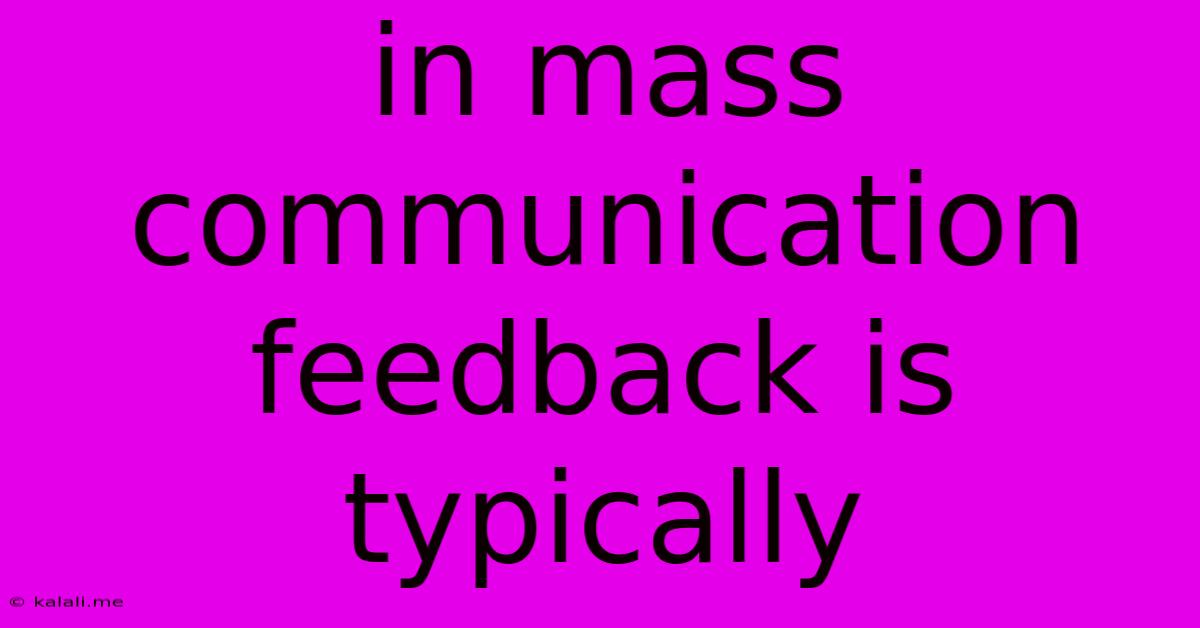In Mass Communication Feedback Is Typically
Kalali
Jun 11, 2025 · 3 min read

Table of Contents
In Mass Communication, Feedback is Typically… Delayed and Indirect
Mass communication, unlike face-to-face interactions, presents unique challenges when it comes to feedback. Understanding the nature of feedback in this context is crucial for effective communication strategies. This article delves into the typical characteristics of feedback in mass communication, exploring its delayed nature, indirect channels, and the implications for communicators.
Meta Description: Learn about the characteristics of feedback in mass communication, including its delayed and indirect nature, and how this impacts communication strategies. Discover how communicators can effectively navigate this challenge.
The Delayed Nature of Feedback
One of the most significant differences between interpersonal communication and mass communication lies in the time lag between the message transmission and the reception of feedback. In face-to-face conversations, feedback is immediate and often non-verbal – a nod, a frown, or a question. However, in mass communication, feedback is typically delayed. This delay can range from a few hours (for online comments on a news article) to weeks or even months (for audience ratings of a television show). This delay makes it challenging for communicators to gauge the immediate impact of their message and adapt accordingly.
This delay also means that the feedback received might not accurately reflect the immediate audience reaction. People may take time to process the information before responding, or external factors may influence their feedback. For example, a negative review of a film might be due to a bad experience at the cinema, not just the film itself.
Indirect Channels of Feedback
Another key characteristic of feedback in mass communication is its indirect nature. Instead of directly interacting with the audience, communicators rely on various intermediary channels to gather feedback. These channels might include:
- Audience ratings and surveys: These provide quantitative data on audience preferences and opinions, but may lack qualitative depth.
- Social media comments and engagement: While providing immediate insights, these channels can be prone to bias and negativity.
- Letters to the editor or email correspondence: Offer more detailed feedback, but often represent only a small segment of the audience.
- Focus groups and in-depth interviews: Provide rich qualitative data, but are often more time-consuming and expensive.
The indirect nature of these channels means that the feedback is often filtered or mediated before it reaches the communicator. This filtering can be intentional (e.g., a news organization selectively publishing positive comments) or unintentional (e.g., a social media algorithm prioritizing certain posts).
Implications for Communicators
The delayed and indirect nature of feedback in mass communication presents significant challenges for communicators. They need to develop strategies to:
- Anticipate audience response: By thoroughly researching their target audience and understanding their values and beliefs, communicators can better predict their reactions.
- Monitor multiple feedback channels: Tracking feedback across various channels provides a more comprehensive picture of audience response.
- Interpret feedback critically: It's important to consider the source and context of feedback before making any major changes to communication strategies.
- Develop a long-term perspective: Since feedback is often delayed, communicators need to be patient and not expect immediate results.
In conclusion, feedback in mass communication is significantly different from feedback in interpersonal communication. Its delayed and indirect nature necessitates careful planning, monitoring, and interpretation of feedback. By understanding these characteristics, communicators can improve the effectiveness of their messages and build stronger relationships with their audiences. Successful strategies involve acknowledging the inherent limitations and proactively implementing mechanisms for gathering and analyzing a range of audience responses.
Latest Posts
Latest Posts
-
How Many Molecules Of Water In A Drop
Jun 13, 2025
-
Which Of The Following Is True About
Jun 13, 2025
-
How To Subtract Rows In Excel
Jun 13, 2025
-
Acceptance Rate For University Of Hawaii
Jun 13, 2025
-
Finding The Area Under The Curve Calculator
Jun 13, 2025
Related Post
Thank you for visiting our website which covers about In Mass Communication Feedback Is Typically . We hope the information provided has been useful to you. Feel free to contact us if you have any questions or need further assistance. See you next time and don't miss to bookmark.